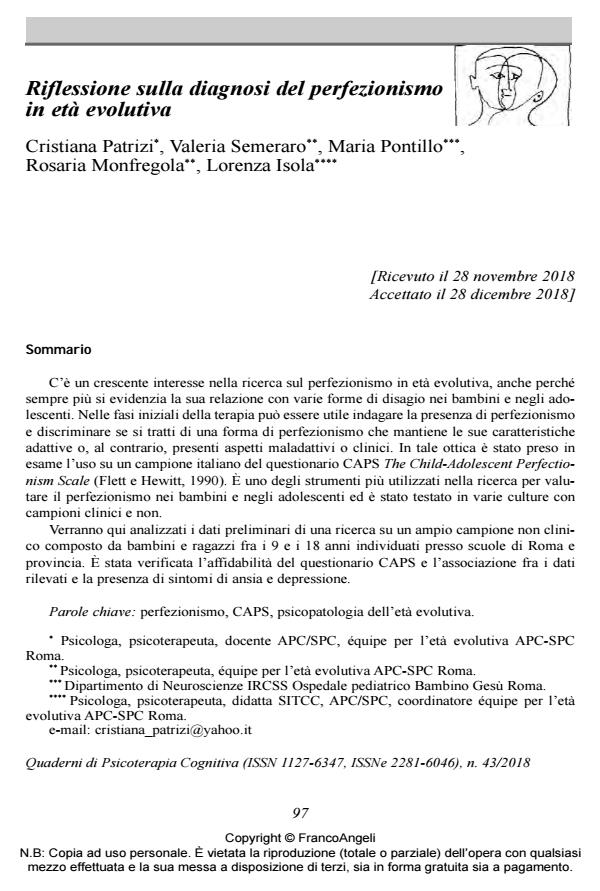Riflessione sulla diagnosi del perfezionismo in età evolutiva
Titolo Rivista QUADERNI DI PSICOTERAPIA COGNITIVA
Autori/Curatori Cristiana Patrizi, Valeria Semeraro, Maria Pontillo, Rosaria Monfregola, Lorenza Isola
Anno di pubblicazione 2019 Fascicolo 2018/43
Lingua Italiano Numero pagine 19 P. 97-115 Dimensione file 107 KB
DOI 10.3280/QPC2018-043006
Il DOI è il codice a barre della proprietà intellettuale: per saperne di più
clicca qui
Qui sotto puoi vedere in anteprima la prima pagina di questo articolo.
Se questo articolo ti interessa, lo puoi acquistare (e scaricare in formato pdf) seguendo le facili indicazioni per acquistare il download credit. Acquista Download Credits per scaricare questo Articolo in formato PDF

FrancoAngeli è membro della Publishers International Linking Association, Inc (PILA)associazione indipendente e non profit per facilitare (attraverso i servizi tecnologici implementati da CrossRef.org) l’accesso degli studiosi ai contenuti digitali nelle pubblicazioni professionali e scientifiche
C’è un crescente interesse nella ricerca sul perfezionismo in età evolutiva, anche perché sempre più si evidenzia la sua relazione con varie forme di disagio nei bambini e negli adolescenti. Nelle fasi iniziali della terapia può essere utile indagare la presenza di perfezionismo e discriminare se si tratti di una forma di perfezionismo che mantiene le sue caratteristiche adattive o, al contrario, presenti aspetti maladattivi o clinici. In tale ottica è stato preso in esame l’uso su un campione italiano del questionario CAPS The Child-Adolescent Perfectionism Scale (Flett e Hewitt, 1990). È uno degli strumenti più utilizzati nella ricerca per valutare il perfezionismo nei bambini e negli adolescenti ed è stato testato in varie culture con campioni clinici e non. Verranno qui analizzati i dati preliminari di una ricerca su un ampio campione non clinico composto da bambini e ragazzi fra i 9 e i 18 anni individuati presso scuole di Roma e provincia. È stata verificata l’affidabilità del questionario CAPS e l’associazione fra i dati rilevati e la presenza di sintomi di ansia e depressione.
Parole chiave:Perfezionismo, CAPS, psicopatologia dell’età evolutiva.
Cristiana Patrizi, Valeria Semeraro, Maria Pontillo, Rosaria Monfregola, Lorenza Isola, Riflessione sulla diagnosi del perfezionismo in età evolutiva in "QUADERNI DI PSICOTERAPIA COGNITIVA" 43/2018, pp 97-115, DOI: 10.3280/QPC2018-043006